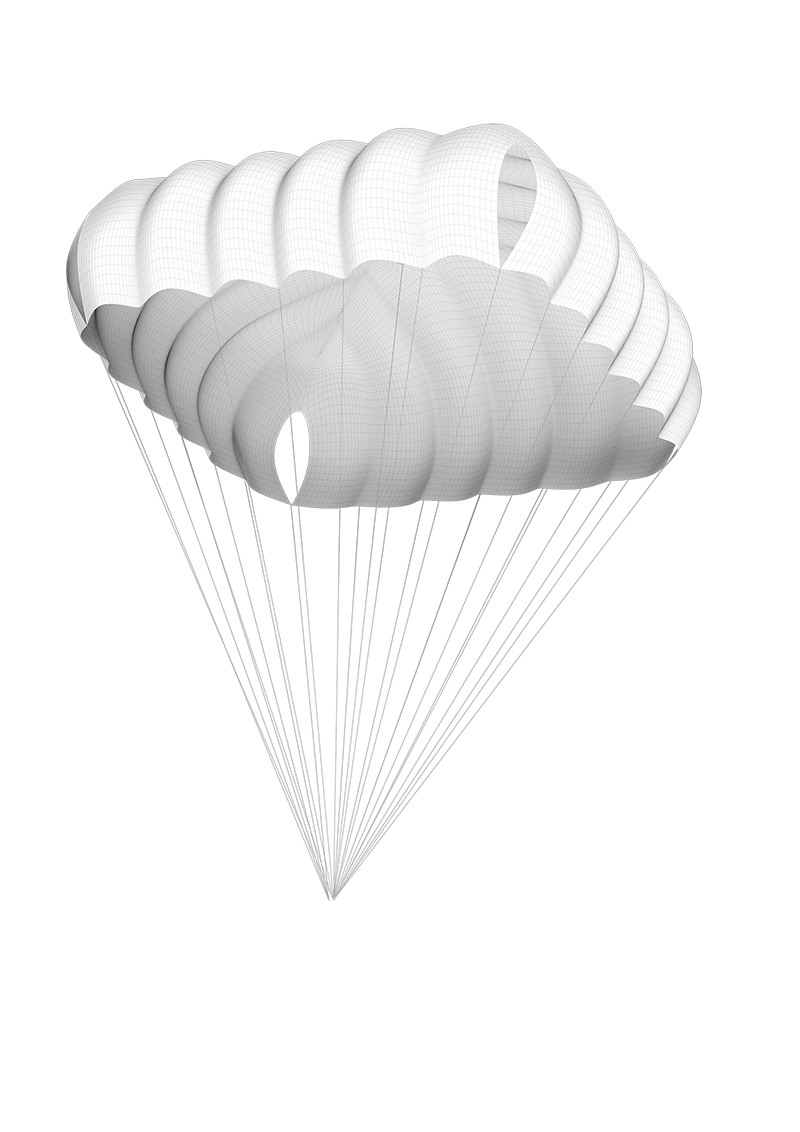Ultralight. Ultra compact.
From now on there is no argument to fly without a rescue! The TAPA X-ALPS ultralight rescue was developed specifically for Hike&Fly and X-Alps pilots for whom every gram counts. The square rescue weighs in at a vanishingly small 784 grams in its smallest size, making it the ideal companion for pilots looking to perfect their lightweight gear.
The TAPA X-ALPS is symmetrically constructed and therefore has no system-related forward motion. On the one hand, this reduces the risk of incalculable drift, and on the other hand, the low sink rate is achieved via the surface – and not via forward motion. Due to its construction, the rescue has an extremely fast opening time and a high descent stability. These factors significantly increase your safety in the event of a rescue descent.
Reliability and strength are ensured by our high quality standards, which are guaranteed by special processing and used light materials. With careful handling and regular packing intervals, you can rely on the TAPA X-ALPS even after many years.


MINIMAL WEIGHT
Starts from 784g

FAST OPENING TIMES

HIGH DESCENT STABILITY

LOW SINK RATES
Due to large surface areas

NO DRIFT
Due to symmetric design

ULTRA COMPACT PACKING
From 2 liters
| Size | 90 | 105 | 125 |
| Area (m²) | 24,80 | 28,05 | 32,59 |
| Weight (g) | 784 | 895 | 1070 |
| Sink Rate (m/s) | 5,3 | 5,3 | 5,3 |
| EN Maximum load (kg) | 90 | 105 | 125 |
| LTF/EN certification | yes | yes | yes |
| Packing volume (l) | 2,0 | 2,6 | 2,9 |
What size TAPA X-ALPS should I fly with?
Check the technical infos of the different sizes (90 and 105) and look carefully at the maximum load figures. Your own take-off weight – this includes your bodyweight, clothing, boots, helmet, canopy, harness, reserve, instruments and anything else you might be carrying – should correspond to the maximum load rating. This ensures minimal sink velocities and injury free landings.
Will the TAPA X-ALPS fit in my harness?
The inner container volume is clearly marked on all our reserves and must be observed during a compatibility check. Most newer harnesses also indicate the minimum and maximum inner container volumes which can be fitted to their deployment containers. Check on the harness itself or in the harness handbook. It is important that the inner container volume lies within the constraints of the harness deployment container volume. Volume information may not be present for older harnesses.
What should I observe when fitting the reserve to my harness?
We strongly recommend letting your reserve be packed and fitted by a qualified expert. Ensuring that the reserve is compatible to the harness and correctly attached to the load loops is just as important as having it correctly packed. A correct compatibility check can only be performed with a trial deployment. Check your reserve regularly – flying at costal sites can in particular lead to corrosion problems around the release splints. Only correctly packed and fitted reserves guarantee your safety!
How do I pack my rescue parachute properly?
We strongly recommend that you have your reserve packed only by a qualified professional, as only this person has the necessary experience and routine and thus an optimal deployment is guaranteed. If you do need to pack your reserve yourself, follow the packing instructions in the manual. However, you should have attended a packing course beforehand and have sufficient routine. You can also download the manual from our website.
Check the packing video here
What is the compatibility check?
During a compatibility check a trial deployment is made under the careful observation of a qualified expert. The check tests that the reserve can be easily released from the harness and inner container with the deployment handle. It is most important that nothing obstructs this proceedure. Correct reserve attachment to harness load loops and that the reserve is the correct size for the deployment container is also checked. Once all the checks have been made, the reserve inner container needs to be re-fitted to the harness in exactly the same way as before!
Does the TAPA X-ALPS drift to achieve its sink rate?
Due to the symmetrical design of all skywalk rescue parachutes (PEPPER CROSS LIGHT, SALSA and TAPA X-ALPS), there is no system-related forward drift. This reduces the risk of incalculable drift. The low sink rate is not achieved by a forward motion, but by a large surface area.
Can I use the TAPA X-ALPS for safety or rescue throwing training?
Our rescue equipment must all go through the same approval process and must meet the same requirements. Generally, rescue equipment is developed for emergency situations and not for continuous use.
If you visually inspect your rescue equipment after a rescue throw, you can, in principle, repack it. However, material fatigue, which can occur due to peak loads, is not detected during visual inspections, since rescue equipment cannot be inspected non-destructively. For this reason, we do not recommend using lightweight rescues for rescue throwing exercises, but rather reverting to conventional rescue devices such as the SALSA.
Can I reuse my rescue after a water landing?
You can reuse your rescue chute under the following conditions:
- Dry your rescue system in a well-ventilated, shady place.
- Avoid direct sunlight and the associated UV exposure!
- Never hang the bridle on the carabiner to dry the rescue in the wind!
- Carry out a visual inspection for any mechanical damage before packing.
How often should a reserve be re-packed?
We recommend re-packing a reserve every 12 months, or immediately should it have come in contact with water. Regular re-packing helps speedy and reliable deployment in the event of an emergency. Packing and fitting should be performed by a qualified expert. We also recommend regular pre-flight checks of container splints and deployment handle attachment – release and re-attach any velcro strips and move the splints a little to prevent them from getting stuck tight. If you’re flying costal sites or in the winter, check your reserve more regularly for any signs of corrosion.
When does the TAPA X-ALPS need to be replaced?
The rescue chute must be replaced after 10 years, even if it has never been thrown.
Do the rescuer connection lines need to be connected with a screw shackle?
An alternative is to connect the two belts by means of loops. In general, looped rescuer connections are no less safe than metal screw connections, as long as this is at all possible and sensible. In addition, looped rescuer connections save weight.
Attention: skywalk equipment offers the possibility of looping between harness and rescue. It is possible that other manufacturers’ equipment is not designed for this. In any case, it is necessary to inform yourself in advance or, if necessary, always resort to the screw shackle.

